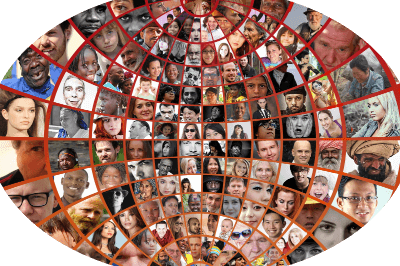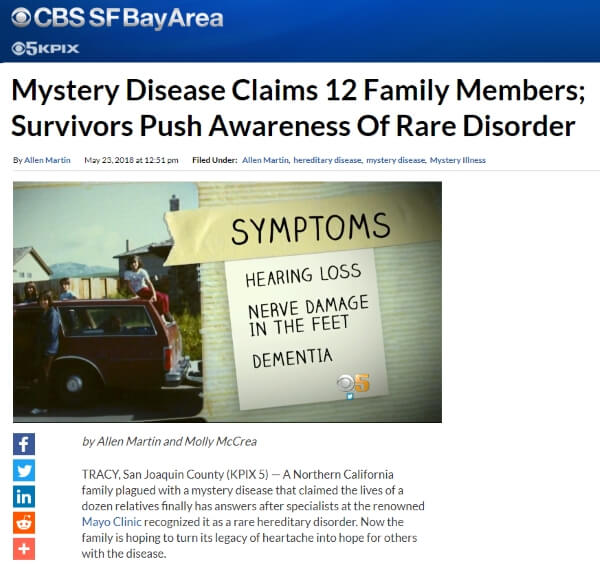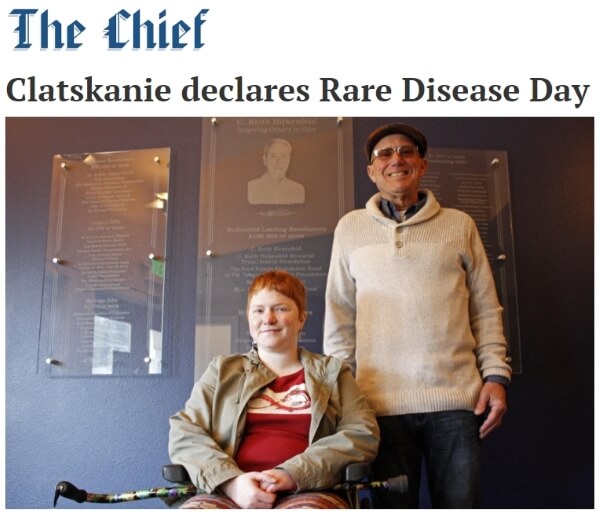Stories from the Community
Stories from the Community
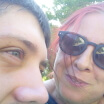
Isabel's Story
My name is Isabel and I am Portuguese. In July of 2014, my son who was at the age of 21, about to turn 22, one day came from university and said I have a swollen foot…. [read more]

Earl's Story
I met my wife, Sandy in 1964, and was married shortly thereafter. At that time there was no knowledge of the disease, or signs of the disease… [read more]
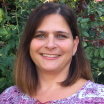
Rachelle's Story
I have lived my whole life playing a genetic version of Russian roulette. In this version the gun is half loaded, leaving me with a 50/50 chance of getting hit… [read more]
Share Your Story
Help grow awareness for the HSAN1E disease by sharing your story! We would love to hear about how you and/or your family have lived with or been impacted by HSAN1E. Please see the form below for more information.
Isabel’s Story
My name is Isabel and I am Portuguese. In July of 2014, my son who was at the age of 21, about to turn 22, one day came from university and said I have a swollen foot. We went to our family doctor and she thought the swelling was due to a toenail fungus and prescribed him an antibiotic. His foot was still swollen after the medication so we went back to the hospital. After a month, we learned that two of his left toes were broken. It was too late for any treatment and the doctors had an elastic bandage put on.
In October 2014, we went to the hospital because the bandage had caused him a sore on his big left toe and was very ugly, again did not feel. He began to undergo treatment three times a week at the medical center. In one of these treatments the nurse found that he had a wound on his foot and once again, he did not feel the wound. Our family doctor informed me that she suspected that my son had no sensitivity and requested a medical examination to that effect. I had also requested an appointment for the orthopedic specialty doctor.
On March 5, 2015, we went to the orthopedic consultation, as soon as the doctor observed the foot, he said it was a “neuropathy”. In September 2015 he was referred to Neurology. Genetic testing was performed and in December 2016 the results came out and positive for HSAN1E.
In Portugal since 2014, there has been a fundraising disease program for neurological disease research. In 2016 the program was dedicated to neurodegenerative diseases, it was from there that I became aware that my son’s disease was much more serious than what I could ever suppose. From then on I was researching the disease and found HSAN1E Society, I contacted Rachelle Dixon and it was my first contact with someone who knew and had dealt with the disease. I felt lost, isolated, in these situations it is always comforting to have someone who can understand us.
Thank you very much to Rachelle and your father, because if I have any hope today is because of the fantastic work they have done. To me this is not a disease, it is more a sentence. My life is now dedicated to my son, all I want in life is to protect him and guarantee him the whole quality of life.
Earl’s Story
I met my wife, Sandy in 1964, and was married shortly thereafter. At that time there was no knowledge of the disease, or signs of the disease.
Sandy’s father starting showing signs of a neurological problem in his early forties. He had trouble with a sore that would not heal on his big toe. This continued on and off for a year or more until the toe was amputated, and then the foot healed normally. There was also a noticeable decline in his hearing, and cognitive ability.
The family was unsure what was occurring, and merely questioned whether his condition was related to his father’s. Doctors in general had little to offer, and not only failed to diagnose the disease, but also the related dementia. In 1974 at the age of 49 he was barely able to walk, and had trouble speaking. Most could not understand him when he talked, and his dementia was quite advanced.
In 1985 Sandy’s older sibling began showing signs of the same condition that affected their father and grandfather. At the time the sibling came to live with us and it was at this time we began going to a genetic clinic, at UC San Francisco, trying to get some sort of answer. In the end we knew only that it was a neurodegenerative disease, autosomal dominant. Nothing was known about it and it appeared there was no history of it anywhere else in the country. Sandy’s sibling died in 1990 at the age of 46 at the time of death, the individual was no longer able to communicate, had serious dementia and was bedridden.
During the process at UC San Francisco it was discovered that Sandy had hearing loss and loss of feeling in her lower limbs. Early signs of the disease that we really had not noticed.
However over the next few years it became apparent Sandy was affected as her condition began to deteriorate. Eventually she was unable to walk, and hearing and speaking became more difficult. Dementia set in and she died in 1997 at the age of 50.
In Sandy’s case the disease took its full course, and she died after a complete shutdown of her bodily functions.
I was told early on that autosomal dominant meant 50% of all descendants affected people could be affected. So I was bracing myself that 2 1/2 of my offspring could be affected. It was my two middle children David and Lisa that began showing signs.
David began showing signs of early onset dementia, and hearing loss in his late thirties. He was unable to hold job, and had to come and live with me. The rest of the family knew this time what we were dealing with and what was to come. But even with this knowledge, trying to talk to doctors was impossible. I would walk into their office with a stack of papers. They would thumb through them looking for anything that had a doctor’s name on it and ignore the rest.
In the meantime David’s Sister Lisa, 11 months his junior, began showing clear signs that she too was affected. Lisa, through her medical insurance, was sent to Kaiser genetic clinic where a geneticist took an interest in her case, and sent her genetic information to a clinic in Southern California for testing.
At the same time David was referred to UC San Francisco for neurological testing. At UCSF the geneticist who was looking at David knew of Dr. Christopher Klein at the Mayo Clinic and his work with a genetic condition similar to our families. Dr. Klein agreed to test David to see if it was the same disease he was working with.
Almost simultaneously Lisa and David received genetic testing results which confirmed the mutated gene. And with that we had a diagnosis and a test. Heredity Sensory and Autonomic Neuropathy, Type 1E. Lisa lost her battle with HSAN1E in 2015 at the age of 48. Eleven months later David lost his as at the age of 49 in 2016.
After the diagnosis, there was a sense of both relief and helplessness. Knowing that we are not as alone as we once felt has been a great relief. But there is still a lot of work to be done. Communication and the sharing of information will be the key to filling the gap between the different doctors and groups of patients, so that no more families and patients have to suffer with the unknown.
Rachelle’s Story
I have lived my whole life playing a genetic version of Russian roulette. In this version the gun is half loaded, leaving me with a 50/50 chance of getting hit.
Round and round the cylinder spins… pull the trigger…
As far back as I can remember there has always been a rare disease in my family. It had no name, treatment or cure. It was so rare that none of the doctors knew what it was. As a little girl I remember wondering what happened to my grandpa on my mother’s side. When I asked I was told, “he died from the family disease.” One summer when I was about twelve years old my mother took me to visit a great aunt of mine. I saw she was using a walker. I asked what was wrong with her, “She has the family disease,” I was told. A few years later as a teenager my mom’s sister came to live with us. I asked why, “she has the family disease” I was told. This was the first time I would see the “family disease” first hand.
These are the basics of the rare “family disease.” The first symptoms start when the person is in their 30’s. It is passed down from parent to child. It starts with hearing loss, then sometime after that comes the peripheral neuropathy causing the person to have balance issues. Then the dementia begins. From then on, it just gets worse. In the end the person is bed ridden, unable to speak, and unable to feed themselves. Their organs begin to shut down leaving nothing left of the vibrant person you once knew.
Round and round the cylinder spins… pull the trigger…
I don’t remember when I first knew my mom had the family disease. Some memories you bury deep. I do remember that over a 15 year period I watched my mom go from being a night nurse for a little boy in a coma to being bed ridden herself, unable to speak, feed herself, or hold her newborn grandson. I know that I was left with feelings of guilt, anger, helplessness, and intense sadness.
At the time of my mother’s passing I was 31. The family disease still didn’t have a name. None of the doctors still didn’t know anything about it. There was no test to take to see if you would get it. Still no treatment, no cure. The disease would take the lives of several more family members before it would make its way back to me and my four siblings.
Round and round the cylinder spins… pull the trigger…
My brother was starting to have a hard time keeping a job, he was having trouble hearing, and he was starting to have a hard time comprehending simple tasks. Eventually my brother moved in with my dad, and my dad became his caregiver. Later that year my older sister had to quit working as well. She was no longer able to live by herself, and so she moved in with me and I became her caregiver.
It was through my brother and sister we were finally able to put a name to the family disease. They both had given DNA samples to their doctors. The doctors were able to see which gene was mutated and match it with other samples. They found that the mutation was in the DNMT1 gene. For the first time we were given a name to the family disease, Hereditary Sensory and Autonomic Neuropathy, Type 1E (HSAN1E). The average lifespan of my family members who have HSAN1E is 50, give or take a couple years. I lost my sister in 2015 at the age of 48 and my brother in 2016 at the age of 49.
Round and round the cylinder spins… pull the trigger…
Shortly after my brother and sister got their results back. I decided to get tested for HSAN1E. I was the first in my family to be given the option. It was an easy decision for me. I had years to think about all the what if’s and I was done playing this cruel game of Russian roulette.
I dodged the bullet…My test results came back negative.
I am now driven by the desire to make sure my loved ones didn’t die in vain. Once we knew there were other families with this same rare disease I felt the need to meet them, to exchange stories with them, and support them in any way I can. My family and I felt the best way we can do this was to start a non-profit. In 2015 we started the HSAN1E Society. My passion for raising awareness for HSAN1E has grown. I am a survivor of this genetic game of Russian roulette and I will spend my time making my voice be heard.

